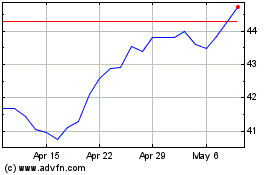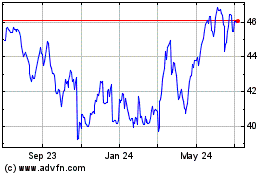FDA Moves to Curb Nicotine in Cigarettes
March 15 2018 - 1:13PM
Dow Jones News
By Saabira Chaudhuri
U.S. health officials took the first concrete steps toward
cutting the nicotine content in cigarettes to nonaddictive levels,
opening a public inquiry ahead of proposed regulations to lower
nicotine levels.
The Food and Drug Administration said Thursday it is reviewing
current science on the role nicotine plays in addiction. It is also
seeking comment from the public on things like where nicotine
levels should be capped, whether caps should be implemented
gradually or all at once, and what unintended consequences could
occur as a result.
"This new regulatory step advances a comprehensive policy
framework that we believe could help avoid millions of
tobacco-related deaths across the country," said FDA Commissioner
Scott Gottlieb.
The agency cited new data published in the New England Journal
of Medicine on Thursday that showed capping nicotine could help
about five million additional adult smokers quit smoking within one
year of implementation. By 2100, the analysis estimates, smoking
rates could drop from the current 15% to as low as 1.4%.
According to the FDA, tobacco use currently kills more than
480,000 Americans each year.
Dr. Gottlieb first announced that the FDA would target nicotine
levels in July, sending shares of Marlboro maker Altria Group Inc.,
British American Tobacco PLC and other tobacco stocks tumbling. The
agency's stance has heightened pressure on big tobacco makers to
invest in reduced-risk products.
On Thursday, Wells Fargo analyst Bonnie Herzog said she believes
it could be up to five years before any potential changes are
implemented.
Philip Morris International Inc. and partner Altria are best
placed to handle the shift away from combustible cigarettes, Ms.
Herzog said. Philip Morris owns IQOS, a device that heats but
doesn't burn tobacco, which has proved popular among smokers in
some countries. The company is currently awaiting FDA approval to
begin selling IQOS in the U.S. through Altria.
Ms. Herzog pointed to recent scientific studies suggesting an
85% reduction of nicotine in cigarettes is ideal.
Nicotine levels in cigarettes can be reduced in different ways.
Manufacturers can adjust the blend of tobacco leaves or use
different types of paper or filters. Nicotine can also be stripped
from the leaf in the manufacturing process. But products with very
low levels of nicotine have never garnered a significant share of
the U.S. market
The FDA has said its approach will consider a continuum of risk
for nicotine delivery, from combustible products such as cigarettes
to replacement therapies like nicotine gums.
"We must make it possible for current adult smokers who still
seek nicotine to get it from alternative and less-harmful sources,"
said Dr. Gottlieb.
On Thursday, the FDA said it would also "imminently" begin the
formal process to build proposed rules on flavored tobacco products
including menthol and, separately, those applying to premium
cigars.
(END) Dow Jones Newswires
March 15, 2018 12:58 ET (16:58 GMT)
Copyright (c) 2018 Dow Jones & Company, Inc.
Altria (NYSE:MO)
Historical Stock Chart
From Mar 2024 to Apr 2024

Altria (NYSE:MO)
Historical Stock Chart
From Apr 2023 to Apr 2024
